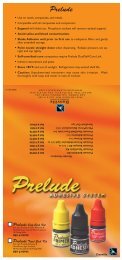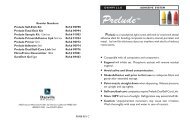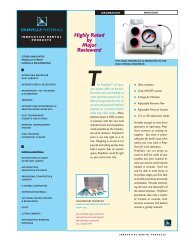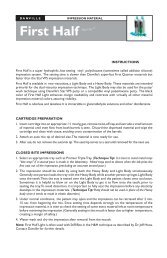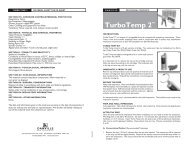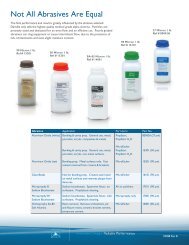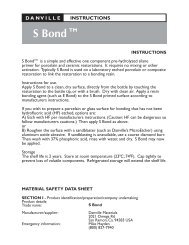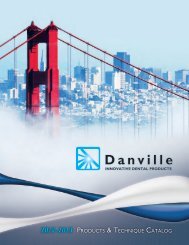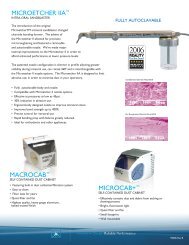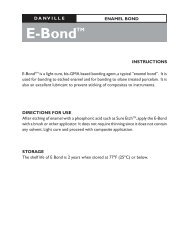Create successful ePaper yourself
Turn your PDF publications into a flip-book with our unique Google optimized e-Paper software.
ACCOLADE <strong>PV</strong>MATERIAL SAFETY DATA SHEETSECTION IX: PHYSICAL AND CHEMICAL PROPERTIES(ND-Not Determined NA-Not Applicable NL-Not Listed)Vapor Pressure mm HG: NDVapor Density (Air=1): NAEvaporation Rate (Ether=1): NA% Volatile by Volume: NASolubility in Water: InsolubleBoiling Point: NDAppearance: Tooth-shaded resin pasteSpecific Gravity: (H2=1):>1Oder: SlightSECTION X: STABILITY AND REACTIVITYStability: Unstable ( ) Stable (X)Conditions to avoid: Prolonged extreme heat beyond 40 deg. C, and intense light.Incompatibility: NDHazardous Decomposition Products: None knownHazardous Polymerization: May occur ( ) Will not occur (X) NoneSECTION XI: TOXICOLOGICAL INFORMATIONNo evidence of carcinogenicity.SECTION XII: ECOLOGICAL INFORMATIONThis material contains hazardous constituents.SECTION XIII: DISPOSAL CONSIDERATIONSDispose of safely in accordance with local, state, and federal regulations.SECTION XIV: TRANS PORT INFORMATIONStable under normal conditions of use, transportation, and storage.SECTION XV: REGULATORY INFORMATION510k #: K020760SECTION XVI: OTHER INFORMATIONNoneThe data and information given in this material safety data sheet are accurate to thebest of our knowledge on the date of preparation. It does not indicate any warrantyor representation.LIMITATION OF LIABILITYExcept where prohibited by law, <strong>Danville</strong> <strong>Materials</strong> will not be liable for any loss ordamage arising from this product, whether direct, indirect, special, incidental orconsequential, regardless of the theory asserted, including warranty, contract,negligence or strict liability.D A N V I L L E VENEER COMPOSITE<strong>Accolade</strong> <strong>PV</strong> TMwith Try-In CompositeBONDING OF PORCELAIN (AND EMPRESS) VENEERS TO ENAMEL AND DENTINWITH ACCOLADE <strong>PV</strong> WITH TRY-IN COMPOSITESACCOLADE <strong>PV</strong> Available in three of the most commonly needed veneer shades plus aunique white opaquer and two shade modifiers, <strong>Accolade</strong> <strong>PV</strong> greatly simplifies veneer bonding. It is alsouseful for all of the usual applications of a ‘flowable’ composite when lighter shades are required. Nowthe system includes unique Try-In Composite built on the same chemistry as <strong>Accolade</strong> but withoutsensitivity to ambient light. The Try-In Composites give the dentist and patient unlimited time to judgecolor match while saving clean-up time and are more precise than typical water-based try-in gels.Selected shades are also available as <strong>Accolade</strong> <strong>PV</strong> Low Viscosity.Porcelain veneer bonding technique suggested by Raymond Bertolotti, DDS, PhD1. Before trying in the veneer, apply a silane (such as <strong>Danville</strong>’s S-Bond) to the uncontaminated,hydrofluoric acid etched veneer. With S-Bond, a phosphoric acid wash of the porcelain is notnecessary.2. Isolate the bonding area, when necessary, with retraction cord (Ultradent #0 cord preferred),immersed in Visine for hemostasis. (Visine will not form a stain at the margin like ferrous sulfatedoes.).3. Place <strong>Accolade</strong> <strong>PV</strong> Try-In Composite on the inside of each veneer (do not use any bonding agentat this time). Try the porcelain veneers both individually and in adjacent groups on the teeth. Aftertry-in, just brush off the Try-In Composite with a dry brush, and if needed select another shade forevaluation. A good neutral starting shade is <strong>Accolade</strong> <strong>PV</strong> Translucent, it is acceptable about 80% ofthe time. If the color needs to be modified due to show-through of the tooth, often a more opaque,light shade is desired. In such a case, try <strong>Accolade</strong> <strong>PV</strong> Light. It works in most cases where the try-inis slightly dark, while <strong>Accolade</strong> <strong>PV</strong> Extra Light adjusts even darker cases. For shade adjustments,<strong>Accolade</strong> <strong>PV</strong> Yellow and <strong>Accolade</strong> <strong>PV</strong> Brown make more dramatic changes. While rarely necessary,any of the shades may be blended. The <strong>Accolade</strong> <strong>PV</strong> White Opaque is very handy as a blender orwhen more whiteness and opacity are desired.4. If the veneer shade trial is acceptable, use a dry brush to remove Try-In Composite from the veneer.Do not use solvent. It is not necessary to remove absolutely all of the Try-In Composite! Theresidue will co-polymerize with <strong>Accolade</strong> <strong>PV</strong> when it is light cured. Set the veneer aside in a safeplace.3420 Fostoria Way Suite A-200 San Ramon, California 94583 USAPhone 925/973-0710 800/827-7940 Fax 925/973-076490927 Rev G
ACCOLADE <strong>PV</strong>INSTRUCTIONSACCOLADE <strong>PV</strong>MATERIAL SAFETY DATA SHEET5. Clean the teeth with pumice and water. <strong>Danville</strong>’s Retract (Kinchloe) instrument is a handy way toprotect the gingival tissue to prevent bleeding. Rinse the tooth with water and dry with oil-free air.6. Isolate teeth to be veneered with interproximal strips (thin metal preferred) to protect adjacentteeth (not being veneered) from the etchant and bonding agent.7. Etch isolated teeth with Sure Etch Gel or Sure Etch Liquid (37% phosphoric acid) for 10 seconds,rinse well, and dab with a dry cotton roll to wick away surface wetness.8. With a micro-applicator, immediately scrub Prelude Adhesive onto each tooth for 10 seconds.Apply Adhesive to veneer bonding surfaces to thoroughly mix the Adhesive with residual Try-InComposite. Air thin to remove the solvent. Do not cure.9. Remove matrix strips prior to placing veneers on teeth. This step assures complete and passiveseating of the veneers, even in multiples.10. Choose the desired shade of <strong>Accolade</strong> <strong>PV</strong> and place on the inside of each veneer. Place veneers in adark area to prevent polymerization, if working with multiples.11. Gently place the veneers on each tooth, preferably all at the same time, and tack in center (around 5seconds) with a small diameter curing light perpendicular to the facial surface, avoiding the margins(the 3 mm diameter Demetron tip is ideal).12. Wave the curing light over the veneer to gel the margins (1 – 3 sec) and remove excess with anexplorer, lifting off the “bead” of <strong>Accolade</strong> <strong>PV</strong>.13. Slide a metal matrix band (ordinary Toffelmire #1 is fine) mesial and distal of one veneer at a timeand light cure for 40 seconds per surface. Thicker veneers may require longer cure times. Notethat the metal bands should be placed at the mesial and distal contacts of only one tooth at a time,preventing difficulty due to additive thickness of more than two bands at a time. Avoid placing amatrix prior to stabilizing (spot curing) the veneer on the tooth. Pressure from the matrix will pushon the veneer, forcing compensation seating pressure that results in broken veneers. The matrixalso tends to displace the veneer from its proper position.14. Inspect the restoration for any voids or incomplete fill areas and the adjacent tooth structure forexisting defects. This is the best time to fill in those areas with <strong>Accolade</strong> (or <strong>Danville</strong>’s Aria, if amicrofill is preferred). Remove the bands and move to another tooth, repeating the procedure.15. Finish gingival margins with <strong>Danville</strong>’s FlashBuster to remove composite flash. Flash-Buster will notdamage porcelain. Finish interproximal margins with a G-C New Metal Strip, 600-grit (GC Dental).16. Polish exposed margins using thin, flexible diamond “Flexis” polishing disks (Vident). These alsowork well when it is necessary to trim or reshape the porcelain. Use <strong>Danville</strong>’s Spinbrite polishingbrushes or Brasseler’s “Dialite” wheel to polish the porcelain.STORAGEBest if stored below 75 O F (24 O C).ADDITIONAL NOTES• WARNING: Use of bonding agents during shade preview may cause prematurepolymerization of Try-In Composite.• Note that all light curing luting agents require a translucent restoration. Increases inopacity require longer curing times or use of a dual-cure luting agent.• Do not store the composite material in proximity of eugenol-containing products, nor letthe composite come into contact with materials containing eugenol. Eugenol can impairthe hardening of the composite and cause discoloration.• Contact of resin composite with skin should be avoided, especially by anyone havingknown resin allergies.90927 Rev GSECTION I: IDENTIFICATIONCompany Name: <strong>Danville</strong> <strong>Materials</strong>3420 Fostoria Way Suite A-200San Ramon, CA 94583Phone (800) 827-7940Fax: (925) 973-0764Prepared: November 2, 2011SECTION II: HAZARD (S) IDENTIFICATIONOSHA Permissible Exposure Limits: NoneOther Exposure Limit Used: NoneACGIH Threshold Exposure Limit: NoneChronic, Other: NoneAcute Overexposure: Irritation to eyes and skin may occur with uncured resins. Maycause skin sensitivity in select individuals.Medical Conditions generally aggravated by exposure: None knownHygienic Practices: NonePrimary Route(s) of Exposure: Skin: Yes. Inhalation and ingestion: NoSECTION III - COMPOSITION/INFO ON INGREDIENTSMaterialBarium GlassBIS GMA%WGT45-65%15-45%OSHA PEL15NLACGIH TLV10NL(ND = Not Determined NA = Not Applicable NL = Not Listed)SECTION IV: FIRST -AID MEASURESSigns of Exposure: Severe skin or eye irritation, redness or burning sensation.Skin: Wash off affected area with soap and water.Ingestion: Seek immediate medical advice, carry container with label.Eyes: Rinse immediately with plenty of water and seek medical advice.SECTION V: FIRE -FIGHTING MEASURESFlash Point: > + 104 deg. FExtinguishing Media: Carbon Dioxide, foam, dry chemicalSpecial Fire-Fighting Procedures: NoneFlammable Limits: NDUnusual Fire and Explosion Hazards: NoneSECTION VI: ACCIDENTAL RELEASE MEASURESNoneSECTION VII: HANDLING AND STORAGESpill Management: Use absorbent to collect the material. Wash contaminated surfaceswith soap and water.SECTION VIII: EXPOSURE CONTROLS /PERSONAL PROTECTIONRespiratory: NoneEye Protection: Safety gogglesGloves: Surgical rubber/<strong>PV</strong>C glovesOther Clothing & Equipment: Face MaskVentilation: None required, local exhaust recommended




